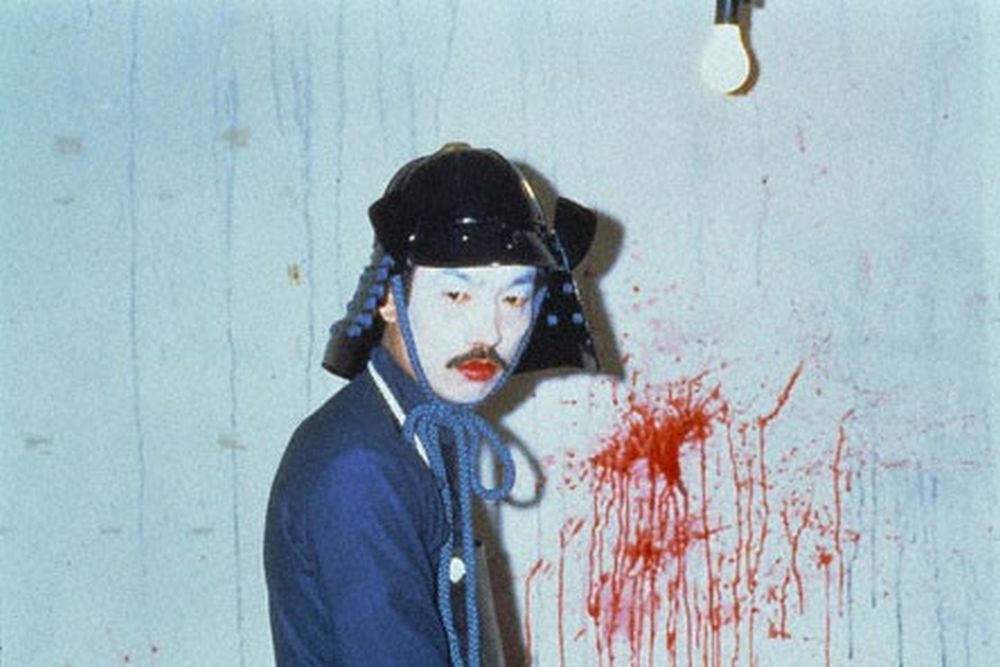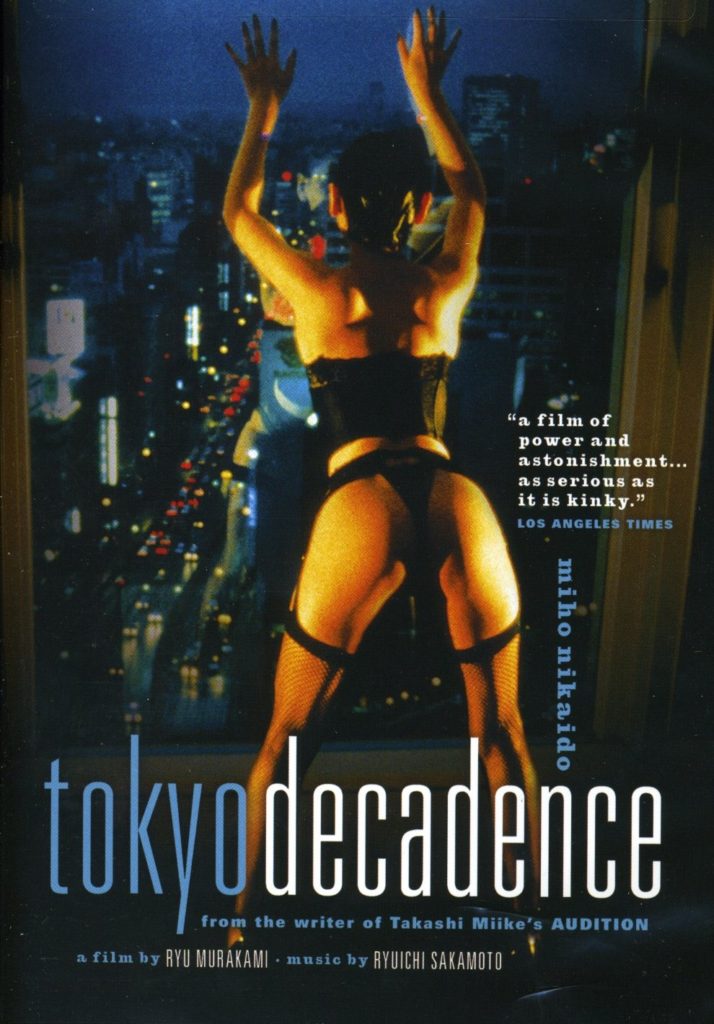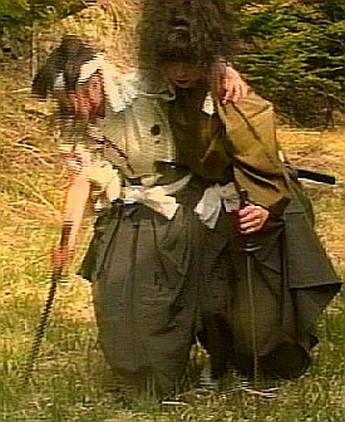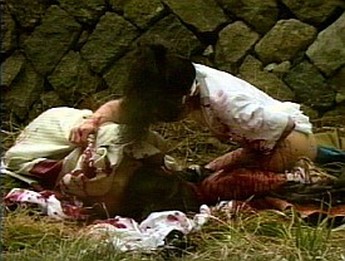Defending the indefensible
‘Guinea Pig’ and other extremes of Japanese film-making
“When crimson blood crawls over a white woman’s skin like a living thing, she blossoms into a flower of flesh and blood whilst drowning again and again in a bloody sea of rapture and ecstacy”
With the effective death of the horror film in Hollywood, or at least it’s absorption into the mainstream, fans have been looking elsewhere for their fix of horror. Germany has given us the works of Jorg Buttgereit; from Hong Kong we’ve had “Man Behind the Sun”; New Zealand produced the wildly warped mind of Peter Jackson. But perhaps the most notorious film of recent years is Japanese: “Flower of Flesh and Blood”, or ‘Guinea Pig’, as it’s often referred to.
It’s almost an hour long and depicts the abduction and dismemberment of a woman by a modern-day Samurai. There’s no plot, no characterisation and speech is limited to some monologues. With few of the cinematic trappings one expects from a film, it’s perhaps not too surprising that soon after it’s arrival, it was suggested the effects are not actually effects, and that it is the often-discussed but never seen creature, a snuff movie.
And the effects are very, very good, especially coming from a country more noted for rubber-suited Godzillas than Savini-style flesh shredding. Some measure of just how good can be gained from the fact that when Customs recently seized a copy being sent to an employee of the National Film Theatre, they had to call in forensic experts to determine it was not real. The poor sod who’d ordered it, instead of the usual wrist-slapping letter, got a six hundred quid fine. HM Customs clearly do not like being made fools of, but this does seem a tad excessive for importing a cassette of special effects. And in America, Charlie Sheen apparently reported the tape to the FBI, proving again that common sense is no prerequisite for an acting career.

Even many die-hard horror fans feel that ‘Guinea Pig’ is pushing the boundaries too far. The film poses a lot of unpleasant questions to the viewer, the most obvious one being the old chestnut, “Why am I watching this?”. One can find justification in several ways – admiring the effects, for example – but none of them allow you to relate to it as a movie; identification with the characters, for example, is near-impossible. But can a better reason be found?
Let’s start by reiterating one thing: it’s not real. It’s merely an entry in a series of semi-underground Japanese films which explore various facets of horror. Strange though many of their moral concepts may seem in our eyes, the Japanese would not permit the open distribution of a snuff movie, and the documentary “The Making of Guinea Pig” gives the game away in any case.
It’s not the first film to have gained notoriety through the supposed ‘death’ on screen of a participant. But the major difference is that films like ‘Snuff’ and ‘Faces of Death’ are obviously fake, to anyone with an ounce of common sense. Watching ‘Guinea Pig’ for the first time, I had almost to adopt the old standby: “Keep telling yourself: it’s only a movie”.
‘Guinea Pig’ represents the horror film in it’s leanest, meanest, stripped to kill sense, reduced to it’s bare essentials. Part of our appreciation of the genre is because we know it isn’t real, and it’s only this basis in fantasy that makes it acceptable; remove the cushioning support of filmic convention and we’re open to the body-blow of raw emotion.
It’s not a film for the non-horror fan, and I can to a certain extent understand the reaction of Customs officers on seeing it, taken out of context. The film is more tolerable – and to some extent makes a lot more sense – when associated with the other entries in the series. My first reaction on hearing about them was “Why?”, but many of the other entries have little in common with the notorious number two, though they are just as strange to Western eyes. One has a woman chased by a flying, pulsating heart, until the icky flesh gobbet is caught in a dustbin by a transvestite and another very bizarre film has a suicidal man discovering he’s immortal no matter what he does to himself. This resembles ‘Tetsuo’ more than anything else – which may not be a coincidence, as the salaryman from said movie does appears in a further member of the series.

The problem with most articles on the film is that they have concentrated on the gore; this is understandable, as a) the gore is most impressive and b) the tape is unlikely to be released anywhere outside its native land and so no-one has gone to the trouble of subtitling it. However, the monologues of the Samurai provide essential insights into the ethics behind the film when they are translated. As the quote at the start suggests, he is an ardent admirer of beauty, although his appreciation is shown in a way which will perhaps only ring bells with fans of Dario Argento! Another key point is revealed in the following:
“Now the woman is in a state of rapture. Due to the drug I injected into her, as can be seen, she is completely unable to feel pain. But, instead of feeling nothing, she feels only ecstacy.”
This is a small but significant alteration to the attitude of the entire film; it becomes clear that pain and suffering are not the aim, in fact they are a positive barrier to observing ‘the flower’, which is the real objective. It’s very much an ongoing process:
“In this world, there is nothing more beautiful. I shall now reveal clearly the ideal of beauty. First the red flower shall bloom from her wrist. [Later: after some disembowelment] Finally, I shall pluck out the jewels. They are the most beautiful part of a woman’s body”
If we have trouble making sense of ‘Guinea Pig’, it may be because we are trying to impose Western values on a peculiarly Eastern product. It was not intended for international consumption, so should not be condemned merely because it adheres to very different moral standards. ‘Guinea Pig’ can be seen as just another facet, an experiment in pushing the limits of the genre ever further. It therefore stands alongside films like Hammer’s versions of Dracula and Frankenstein, condemned as repulsive and obscene when first released. Time mellows all things: maybe, in 30 years time, we’ll be seeing ‘Flower of Flesh and Blood’ on TV.
“Thusly, this flower of flesh and blood has bloomed completely…”

Tokyo Decadence Topaz (Ryu Murakami)
Miho Nikaido, Sayoko Amano, Tenmei Kanou, Masahiko Shimada.
This is, for the most part, a very shiny film. It tells of ‘Ai’ – the Japanese word for love – a Tokyo call-girl who works for an S/M agency. Much of the film is taken up with languorous portrayals of her activities, the clients she serves, ranging from coked-up yakuza to spoilt yuppies, via almost every form of bondage, domination and humiliation you can conceive (plus a few more you probably can’t!). The heroine does, however, balk at pretending to be dead…
It’s the stuff of which ultra-warped commercials are made, as it’s shot through with a highly deformed gloss. A lot of it seems to happen in real-time, too, which has both benefits and penalties. It adds a realistic edge, but S&M games are no different from any other porn, in that after a while, their interest value diminshes rapidly, unless you’re a real connoisseur of such things.
After, oh, maybe 80 minutes of this, we get something vaguely recognisable as a plot. Or at least, something happens. After an especially aberrant session – just her, a dominatrix called Saki, a patron, a fruitbowl, a whip, an Art Deco dress and a plastic penis – Ai does some drugs with Saki and resolves to find herself. She does, after a fashion, but it’s not quite what you’d expect, though the ending is not conclusive one way or another. Er, if you get my drift….
Despite this being the only section with anything like a story-line, I felt this section was the film’s weakest. Director Murakami seems happiest when dealing with the twilight world behind locked hotel doors, his style doesn’t transfer well to the suburbia where the film’s terminates (the word ‘climaxes’ isn’t appropriate in any of it’s senses!).
But is this ArtPorn or it PornArt? On balance, probably just the latter, though it’s chances of getting released in this country evaporated after less screen time than any Traci Lords film I’ve seen. But it’s probably too varied to appeal to the tastes of any one devotee, and in any case, it’s got music by Ryuichi Sakamoto, who shared an Oscar for ‘The Last Emperor’. I don’t think his career has gone downhill that far!
Two Girl Warriors in Hara-Kiri

Even as Japanese films go, this is very strange. The title says it all: a pair of nameless female samurai, leaving the scene of a battle, commit ritual suicide. There is no significant dialogue and the action, such as it is, happens in real-time, making the 42 minutes duration seem several times longer.
I really don’t know why I like this film so much. It gives the impression of being a chunk taken from the middle of some great Kurosawa epic, leaving the viewer to fill in the blanks. Who are the characters? Are they related to each other? Why were they in battle? How did they get injured? And, even though the only two characters in the film are dead by the end, you feel there must be something more. Maybe a relative finds the body and seeks revenge? The film, perhaps wisely, doesn’t try to answer these questions, leaving them instead for the viewer’s imagination.
The film is as much concerned with the ‘ritual’ as the ‘suicide’, every detail of the preparations, mental and physical, is carefully depicted with near-fetishistic precision. This takes up a significant part of the running time, but gives an added punch to the actual suicide, when it eventually starts.

Which is when it becomes difficult to watch, especially for a Western consumer used to movies where death is quick, simple and – crucially – painless. None of this is true in ‘Two Girl Warriors’. The second half of the film relentlessly shows the slow and painful process involved in the reality of death, as first one girl, then the other, commits seppuku.
Despite the lack of dialogue, the warriors are substantially more than ciphers, or models for splatter and gore (those expecting a ‘Guinea Pig’ style atrocity exhibition will be disappointed – the special effects are competent, but really don’t seem to be the point). One is hesitant, and unwilling to do ‘the right thing’, the other has a fatalistic stance. In less than 45 minutes, the characters are better developed than many Hollywood movies manage.
This is one in a series of films, including ‘Lost Paradise’. While all are undeniably odd, the others tend to a certain sameness; there are only a limited number of ways one can show a girl slitting her stomach open. But the dramatic tension ‘Two Girl Warriors’ generates, lifts it above the rest, and propels it alongside the likes of ‘Videodrome’ and ‘Miracle Mile’ for it’s relentless depiction of death. But while those two films almost make death appealing, as an escape, ‘Two Girl Warriors In Harakiri’ suggests that it may be far worse than you expect.
Pretty Body: Frankenstein’s Love
If the preceding film seemed strange – and if it didn’t, I recommend therapy – then at least it was clear what was going on. But in ‘Pretty Body’, the puzzle is less what is taking place than why. The whole creature resembles a cross between ‘Flesh for Frankenstein’ and ‘The Rocky Horror Picture Show’; if you can imagine trying to watch the latter in a language you don’t comprehend, you’ll have an idea of the mood instilled by ‘Pretty Body’.
A girl moves into a flat in a seaside block occupied by some indubitable odd-balls, most notably the couple who engage in icky sex reminiscent of ‘Society’ and the mad ear doctor on the floor below who is assembling a “monster”, although that’s the wrong term as it looks more like something out of the Chippendales. The girl accidentally meets the creation, and becomes fascinated by it, to the extent of crawling through the air-conditioning to meet it. When she finally does, they sing a duet. They are interrupted by the doctor, who is then set on fire, and the creature’s brain swells up and explodes. The film ends with the heroine throwing an eyeball into the ocean.
Ever feel like you were missing something somewhere? Also involved (somehow!) are a schoolgirl who gets her intestines punched out, a point-of-view shot from inside an ear and a monster-as-ventriloquist variety-show sequence. It’s all crammed into 54 minutes, which makes me wonder about it’s origins – too icky for TV, too short for a movie (and not letterboxed either), it’s just an all-round curious animal!
